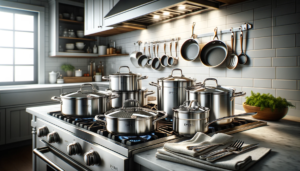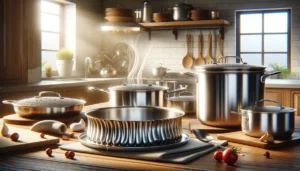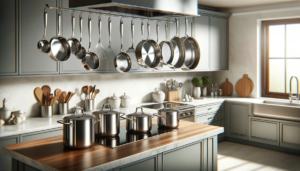If your Calphalon stainless steel cookware has lost its shine and you’ve scrubbed to no avail, discover how to revive its original brilliance.
Learning the proper cleaning methods and care for Calphalon stainless steel cookware maintains beauty and performance for the long haul.
Let’s dive into essential supplies to have on hand, a system for routine washing, resolving challenging stuck-on stains, steps for preventative care, and when calling in professional reinforcements makes sense.
How to Clean Calphalon Stainless Steel Cookware

To clean Calphalon stainless steel pots, pans, and lids, allow them to fully cool after cooking then wash by hand using warm water mixed with a small amount of mild dish soap.
Gently scrub the interior and exterior with a soft sponge or cloth, rinse thoroughly, then immediately and completely dry with a clean towel.
For stuck-on residue, make a paste of baking soda and water and gently scrub affected areas before rinsing.
Boil water and vinegar to dissolve mineral deposits.
Avoid abrasive scrubbers and use non-metal utensils to prevent scratches.
Handwash only and rub with oil occasionally to maintain the stainless steel’s shine.
Supplies Needed
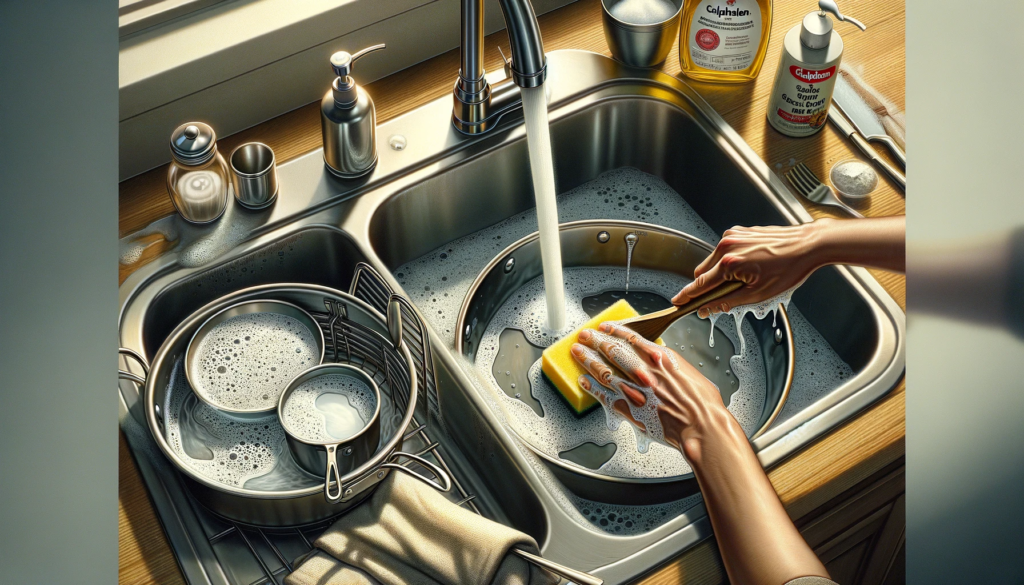
Keeping your Calphalon stainless steel cookware looking shiny and new requires having the right cleaning supplies readily available.
For routine washing, you’ll want to have dish soap or detergent on hand.
Opt for a mild liquid or powder variety rather than anything too harsh or abrasive that could damage the cookware over time with repeated use.
Standard dish soap helps cut through grease and lift food residue from pots, pans, and lids without being overly abrasive on the stainless steel surface.
Make sure to have soft sponges, cloths, and scrubbing pads as well.
These allow you to apply some light elbow grease when needed without introducing scratches.
Any soft textured wiping material will do, but be sure to avoid stiff-bristled brushes and abrasive scrubbers that could mar and dull the metal finish.
For more stubborn stuck-on messes, baking soda can be extremely useful.
Mixed with a small amount of water, baking soda makes a mildly abrasive paste that breaks up residue without being too harsh on the stainless steel.
Its gritty yet powdery texture lets it penetrate cooked-on oily films and sooty deposits that routine dish soap may struggle to budge.
Distilled white vinegar is another cleaning cabinet staple for dissolving some deposits and stains.
The acetic acid in vinegar cuts through mineral buildup like limescale as well as dingy grease.
For truly tough cleaning challenges, a specialty stain remover made for stainless steel such as Barkeepers Friend may be needed.
This type of cleaner contains oxalic acid tailored to lifting discoloration without scratching metal surfaces.
No matter which cleaning solutions you reach for, always have access to warm water rather than just cold when washing cookware.
The increased temperature helps the cleaners better penetrate and dissolve sticky oils and cooked-on foods.
Warm water alone often removes some mess before even needing soap.
And of course, clean towels will be needed to thoroughly dry pots and pans after rinsing to prevent water spots.
Taking a little time to assemble the right stainless steel cookware cleaning supplies makes the job much quicker and easier.
Routine Cleaning After Each Use

Preventing stuck-on mess buildup in the first place is key to keeping Calphalon stainless steel looking its best with minimal effort.
That’s why consistent cleaning immediately after using the pots, pans, and lids is so important.
Start by fully allowing the cookware to cool off after cooking.
The metal will rapidly conduct heat, making it able to be comfortably handled in just a few minutes after removing it from the stovetop or oven.
Immersing extremely hot pans into cold water can damage them through sudden temperature changes and lead to warping.
So allow the pieces to come to room temperature first.
Once cooled, wash the soiled cookware by filling the pan or sink with warm water and adding a small squirt of mild dish soap, such as Dawn or Palmolive.
Using a soft sponge or cloth, gently scrub away any visible stuck-on bits and greasy residue still clinging to the interior cooking surface, exterior sides, handles, lids, and lid rims.
The warmth of the water enables the cleaning solution to better penetrate compared to washing in cold water.
Be thorough but delicate, cleanly wiping every section of the cookware while taking care not to scratch the stainless steel finish.
Repeat the process as needed on heavily soiled pieces, using a bottle brush for any narrow openings.
After washing, carefully rinse off all the soap residue under warm running water, including the bottom exterior of pans where grime loves to hide.
Then fully dry the clean stainless steel immediately with a fresh towel rather than air drying, as this minimizes water spots.
For an added protective boost, occasionally rub down the exterior metal surface with a tiny drop of cooking oil once dried, using another clean cloth.
This maintains the signature shine of Calphalon’s brushed stainless steel while sealing it against corrosion.
Removing Stubborn Residue or Discoloration
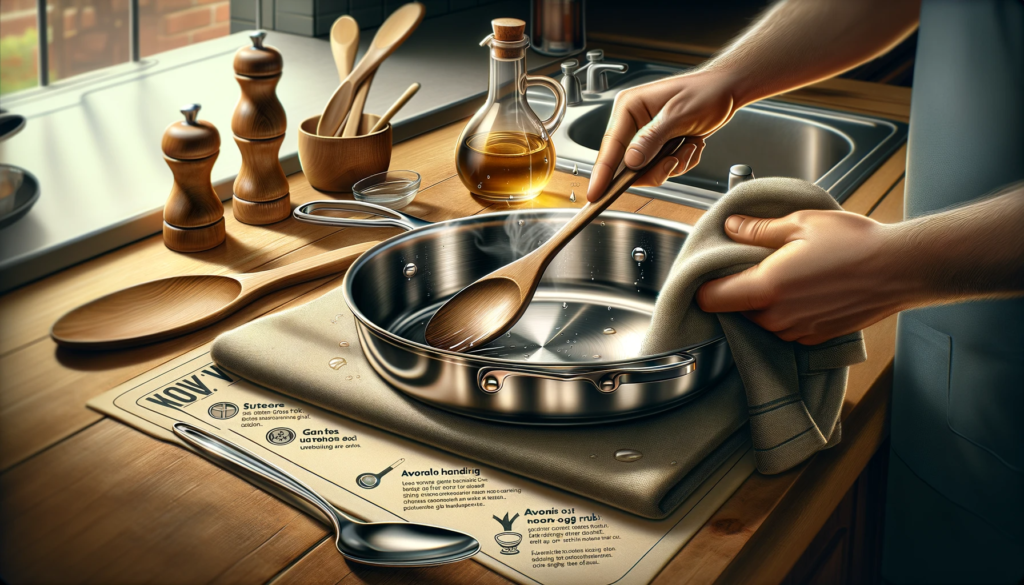
Though Calphalon stainless steel stands up quite well to regular stove and oven use with proper routine care, you may eventually face some stubborn residue, staining, or heat discoloration requiring a bit more attention to remove.
Pasta sauce, oil splatter, egg films, meat drippings, seared bits, baked cheese or milk solids, pepper specks, mineral deposits, heat rings, and other stains can happen despite your best efforts.
Tackling these tougher cleaning challenges calls for breaking out the baking soda and vinegar rather than hoping routine dish soap alone will do the trick.
The good news is combining these natural cleaning solutions with some focused scrubbing often makes the cookware look refreshed and good as new again.
For stuck-on grease, sauces, or food residue, make a gritty paste by stirring baking soda with just enough water to form a loose texture akin to wet sand.
Apply the paste to affected areas of the stainless steel cookware using a soft cloth or sponge.
Generously coat any hardened bits or visibly dingy areas inside and out.
Allow it to set for several minutes to penetrate.
Then gently yet firmly scrub back and forth in the direction of the brushed metal grain, allowing the baking soda micro-abrasion to lift stains without damaging the steel.
Thoroughly rinse away all paste residue and inspect to see if the stuck-on gunk has lifted.
Repeat the application if needed for really stubborn buildup before washing as normal.
For discoloration like heat stains or mineral deposits inside pans, boil a 50/50 mixture of distilled white vinegar and water for 5-10 minutes.
This acid treatment helps dissolve compounds causing clouding, rings, and film buildup that routine dish soap can’t tackle alone.
Allow the solution to cool for a few minutes before scrubbing to avoid burning your hands.
Use a soft cloth and gently rub stained areas to lift discoloration, continually rewetting your cloth in the solution as needed while scrubbing.
After complete vinegar water coverage, do a thorough rinse and dry.
Inspect and spot clean any lingering marks.
For very stubborn interior stains, reach for stainless steel specialty cleaner Barkeepers Friend.
Follow product label instructions to gently yet effectively remove discoloration without damaging the delicate brushed metal grain patterns.
This cleaner adds extra stain-fighting compounds dish soap lacks, letting you rescue badly neglected cookware.
Maintaining Appearance and Performance

While having the occasional deep cleaning session renews stainless steel’s appearance, taking some simple steps during daily use maintains the cookware’s good looks and performance for the long run.
Avoid subjecting Calphalon pans and pots to excessively high heat settings, for example, as warping and interior discoloration can result, ruining both aesthetics and functionality.
For most cooking tasks, a medium or lower stove burner setting suffices so there is no need to crank the burner temperature dial to high.
You’ll also want to prevent scratching and metal damage from harsh scrubbing or utensils.
Always use wood, silicone or plastic cooking implements instead of metal so you avoid nicking and gouging the cookware surface.
Wash all pieces by hand rather than the dishwasher, as high heat drying cycles and caustic automatic detergent also dull stainless steel’s appearance over time.
Get in the habit of consistently hand cleaning cookware promptly after cooking rather than letting foods dry and harden on the metal.
Avoid using stiff-bristled scrub brushes and super abrasive scouring pads too, as these can create micro-scratches impairing stain resistance and easily show swirl marks on stainless steel’s surface.
Of course, the most vital maintenance step is properly and thoroughly drying your Calphalon pieces after each hand wash to prevent mineral spots from tap water and corrosion damage.
Immediately rub the cookware exteriors and interiors dry using clean, soft towels so no moisture lingers.
Adding a light wipe down with a tiny drop of any cooking oil (like grapeseed or canola oil applied to a paper towel) creates a protective barrier maintaining the flawless brushed metal finish and prevents surface oxidation from humidity or storage.
Repeat oil application every few weeks for pots and pans used frequently.
When to Consider Professional Cleaning
Even if you faithfully care for your Calphalon at home through daily maintenance and proper cleaning methods, you’ll likely come across some extremely stubborn stains or dinginess that just won’t budge eventually.
Darkened heat rings inside pans, cloudy mineral buildup, bite marks from metal utensils, tough water scale adhesions and similar heavy residue might require professional intervention after much effort yields little visual improvement on your part.
Before throwing in the towel, contact a metal cookware cleaning company to see if they can revive the pieces.
Commercial cleaning services have access to specialized equipment and intensely potent chemical solutions homeowners lack, making them the last resort for badly neglected cookware repair.
Ultrasonic stainless steel cookware cleaning in particular uses high frequency sound waves and cleaning agents to meticulously lift embedded grime and finish dulling films.
The process restores stained cookware to like-new condition again through simultaneous precision cleaning and sanitizing without damage.
Cookware restoration experts can also resurface minor scratches and scuffs.
Conclusion
Properly caring for Calphalon stainless steel cookware ensures it remains beautiful and fully functional for years of cooking enjoyment.
With the right supplies and consistent cleaning techniques, you can keep pots, pans, and lids looking polished and prevent damage.
Putting some periodic extra elbow grease into removing stuck-on residue restores items to like-new condition when needed.
And remembering preventative steps such as air drying and utensil care makes maintaining the cookware’s appearance far easier.

